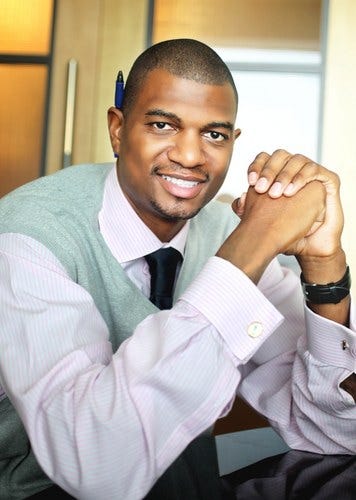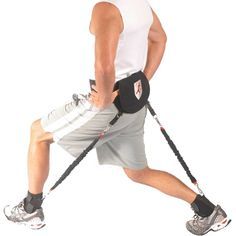DIY Device Helps an Injured NBA Player Return to the Court
January 13, 2015
|
|
After being drafted out of high school, Jonathan Bender seemed poised for stardom in basketball. Playing for the Indiana Pacers in his first NBA game in 1999, he scored 10 points in 13 minutes, becoming the first player drafted from high school to score double figures in an NBA debut. In the next couple of years, however, his left knee began to give him trouble, and he later had arthroscopic surgery to address the problem. The procedure only made things worse, and he was forced to retire in 2006.
Bender came up with the idea for a device to strengthen the knees while sitting on a bench in Houston watching people run. He wanted to create a device that would build muscle without aggravating the joints. It then dawned upon him that he could create a device that could serve as an external hamstring. Elastic bands would be connected to the lower back via a belt and ankle sleeves, strengthening the lower extremities in the process.
The product would be eventually commercialized as the JB Intensive Trainer, a Class I medical device.
(Ed Note: Bender will be sharing the development story behind the device at MD&M West on February 11, 2015. His talk begins at noon on the event's Center Stage.)
After coming up with prototypes for the device, using duct tape, a belt, wire cutters, and so forth, he began testing it out for himself and found promising results. He eventually enlisted the help of Purdue University to confirm the product's clinical efficacy. In 2009, he was able to return to the NBA, playing a season for the New York Knicks. At that point, his lower extremities were the strongest of anyone playing for the team, according to the Knicks team doctors.
"When I went back to go play for the team, they tested all of my different muscles. I went through numerous tests," Bender recalls. "For instance, I would stand on one leg, bend it to 90 degrees, and then come back up. Or I would bend the leg and seeing how long I could hold it."
All of the team members undergo such testing, and Bender says he had the highest score of any Knicks player that year.
To get to that point, Bender used his device every other day or so for about 30 minutes for about two years.
Bender discusses the history of the device on NBA TV. |
The device helped in a number of ways, Bender says. It strengthened his lower extremities while taking pressure off them and strengthened his core. "It helped tremendously in improving my balance and my overall body awareness," Bender says.
He had the opportunity to continue playing in the NBA in the 2010-2011 season, but decided instead to found a company to commercialize his invention.
The more he tested the device out, the more promise he felt it had.
When he first developed the JB Intensive Trainer, he didn't know that it would be so effective in relieving pressure on the lower extremities. "The product has a sort of zero gravity effect. Once anybody puts it on, they get that feeling like they are walking on the moon or walking in water," Bender says. "The bands in the device unload the joints while giving the muscles resistance to strengthen them."
Essentially, Bender's device was able to accomplish the same objectives as rehab for the knees: strengthen the joints while protecting them.
|
The JB Intensive Trainer acts as an external hamstring. |
He initially wanted to create a device to make muscles stronger and to even out the strength of the muscles in the left and right sides of the body. "I really didn't know what to expect. Even before the Purdue University research came out, I tested the device on numerous people and myself and was able to wear it and not really feel the pain I felt before," Bender recalls. "I knew I was onto something."
"On many occasions, we have taken individuals with canes and achieved extraordinary results with the device. They could be 70 or 90 years old. They could have osteoarthritis in the knees to the point where they can hardly walk," Bender says. "We put them in the device and as soon as they are set up, they are walking. We are putting them in a zero gravity zone and are engaging the muscle."
The Baby Boomer generation is in fact the biggest consumer base for Bender's company. "My focus is showing that this was not just for athletes. It is a medical device that is going to help the older generation," he explains.
The company is coming out with a sports model in 2015. "It is going to be geared towards athletes," Bender says. "It still will have Zero G technology but we will focus more on athletes like Derrick Rose, who has had a history of knee problems. We want to get in there and do movements at the speed he needs to really focus on strengthening those muscles around his knee."
The device will have a slightly different design. "Everything is a little bit heavier and more secure. It is kind of built to take a beating," Bender says. "Some of the accessories are geared more towards sports and the resistance will be a little higher."
The new device will also be suited for weekend warriors who are injured and have to take time away from a sport they love because of a knee injury. "They can use the device to get to the point where they can run and get back out there," Bender says.
Hear more about Bender's device story in person at MD&M West, held February 10-12, 2015 in Anaheim, CA. |
Brian Buntz is the editor-in-chief of MPMN and Qmed. Follow him on Twitter at @brian_buntz.
About the Author(s)
You May Also Like




